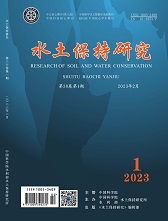[1]ZHANG Wei,WANG Jia-zhuo,REN Xi-yan,et al.GIS-based Ecological Sensitivity Analysis of Mountainous Areas[J].Research of Soil and Water Conservation,2013,20(03):44-47,54.
Copy
GIS-based Ecological Sensitivity Analysis of Mountainous Areas
Research of Soil and Water Conservation[ISSN 1005-3409/CN 61-1272/P] Volume:
20
Number of periods:
2013 03
Page number:
44-47,54
Column:
Public date:
2013-06-28
- Title:
- GIS-based Ecological Sensitivity Analysis of Mountainous Areas
- CLC:
- TU982.2
- DOI:
- -
- Abstract:
- Ecological sensitivity analysis is frequently used in urban planning. A typical mountainous city (Gucheng county) is studied. Five factors are selected to evaluate the eco-sensitivity, including slope, elevation, vegetation cover, geologic hazards, and buffer zone of rivers. Ecological sensitivity is classified into five grades, that is extreme sensitivity, strong sensitivity, moderate sensitivity, slight sensitivity and insensitivity. The overall ecological sensitivity is evaluated and displayed on space scale by using analytic hierarchy process (AHP) and spatial analysis in Geographical Information System (GIS). The area percentages of the five grades are 23.96%, 13.56%, 36.68%, 17.26% and 8.54%, respectively. Ecological function regions are determined based on the evaluation results and advice for each region is given respectively to provide the scientific support for urban planning and land use aiming to reduce the risk of ecosystem damage.
- References:
-
[1] 欧阳志云,王效科,苗鸿.中国生态环境敏感性及其区域差异规律研究[J].生态学报,2000,20(1):10-13.
[2] 韩贵锋,赵珂,袁兴中,等.基于空间分析的山地生态敏感性评价:以四川省万源市为例[J].山地学报,2008,26(5):531-537.
[3] 张磊,刘利强,胡海波,等.基于区域开发的钦州市生态敏感性分析及防控对策[J].生态与农村环境学报,2009,25(3):16-20.
[4] 叶其炎,杨树华,陆树刚,等.玉溪地区生物多样性及生境敏感性分析[J].水土保持研究,2006,13(6):75-78.
[5] Cariboni J, Gatelli D, Liska R, et al. The role of sensitivity analysis in ecological modeling[J]. Ecological modelling,2007,203(1):167-182.
[6] 罗鹏,石军南,孙华.基于GIS空间模型的库区生态敏感性评价研究[J].水土保持研究,2007,14(2):255-258.
[7] 潘竟虎,董晓峰.基于GIS的黑河流域生态环境敏感性评价与分区[J].自然资源学报,2006,21(2):267-273.
[8] 杜军,姚孝友,孙希华,等.基于GIS的山东沂沭泗河流域土壤侵蚀敏感性评价[J].水土保持研究,2006,13(1):165-167.
[9] 岳书平,张树文,闫业超.东北样带土地利用变化对生态服务价值的影响[J].地理学报,2007,62(8):879-886.
[10] 刘康,欧阳志云,王效科,等.甘肃省生态环境敏感性评价及其空间分布[J].生态学报,2003,23(12):2711-2718.
[11] 陈诚,陈雯,王波.环太湖地区环境敏感区划定与分区[J].经济地理,2009,29(1):97-101.
[12] 吴克宁,韩春建,冯新伟,等.基于3S技术的土地生态敏感性分区研究[J].土壤,2008,40(2):293-298.
[13] 杨月圆,王金亮,杨丙丰.云南省土地生态敏感性评价[J].生态学报,2008,28(5):2253-2260.
[14] 单勇兵,李志江,马晓冬.基于GIS的徐州生态敏感性分析[J].水土保持研究,2011,18(4):244-247.
[15] 尹海伟,徐建刚,陈昌勇,等.基于GIS的吴江东部地区生态敏感性分析[J].地理科学,2006,26(1):64-69.
[16] 李阳兵,邵景安,王世杰,等.基于岩溶生态系统特性的水土流失敏感性评价[J].山地学报,2007,25(6):671-677.
[17] Chen Y, Yu J, Shahbaz K, et al. A GIS-Based Sensitivity Analysis of Multi-Criteria Weights[C].18th World IMACS/MODSIM Congress, Cairns,2009:13-17.
[18] Chen Y, Yu J, Khan S. Spatial sensitivity analysis of multi-criteria weights in GIS-based land suitability evaluation[J]. Environmental Modelling & Software,2010,25(12):1582-1591.
[19] 杨志峰,徐俏,何孟常,等.城市生态敏感性分析[J].中国环境科学,2002,22(4):73-77.
[20] 赵焕臣.层次分析法:一种简易的新决策方法[M].北京:科学出版社,1986.
[21] 徐建华.现代地理学中的数学方法[M].北京:高等教育出版社,2002.
[22] 边馥萍,杨正方.城市用地选择的系统分析及程序设计[J].城市规划,1997(2):48-51.
- Similar References:
Memo
-
Last Update:
1900-01-01
